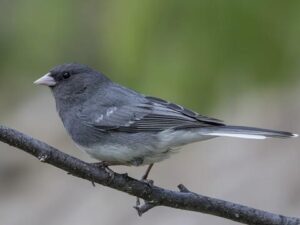
Is there a dark bird, pecking frantically under the feeder in your yard this winter? It is probably a Dark-eyed Junco, and it is one of the rare birds that likes cold weather! With the appearance of Juncos in your yard, winter is near. When they disappear, spring is just around the corner.
Characteristics
Juncos do migrate south for the winter, but only as far as Michigan, Wisconsin, Minnesota and New York. Occasionally, the male will migrate farther south, depending on the upcoming winter conditions. No matter where they end up, Juncos remain in large flocks through the winter season in northern North America. During the summer, they fly north to the cool climate in Canada and extreme northern regions of the United States.
Juncos are strict followers of the pecking order, meaning they chase away timid and non-dominant birds. They aren’t bothered by other species, either. A Junco has no qualms about fending off a Blue Jay or Starling from its desired feeding location.
Physical Traits
The Dark-eyed Junco is a small bird, standing around 5” tall. The males are slate gray to black in color with a white underbelly. The female is a lighter or brownish shade of gray, with the white underbelly. The juvenile will look like the female but have streaked colors until it is mature. When the birds fly off, the wings look black and white striped as they fly away.
Nesting
A pair of juncos will mate early in the spring. Together they build the nest that will house both of the two broods they produce in one season. Each brood will have between three and five white eggs that have reddish markings. The female incubates the eggs alone until they hatch, which is between ten and fifteen days. Both parents will feed the young until they leave the nest, two to three weeks later.
Food Supply
The junco will eat seeds from a platform or hopper style feeder. Its favorite seeds are millet and smaller bits of corn and sunflower that get scattered on the ground from the feeders above. The little birds will forage on the ground, under leaves and in bushes near feeders to find seeds. They also eat bugs during the spring, summer and fall when they are plentiful in the north!
The Dark-eyed Junco is a good indicator of the changing seasons. Even though it is a common bird during the winter months at and under your feeder, you will rarely see it during the spring or summer unless you live in a chilly climate. Once they do appear at your feeder, take heed and finish your winter preparations. Snow will be just around the corner!
